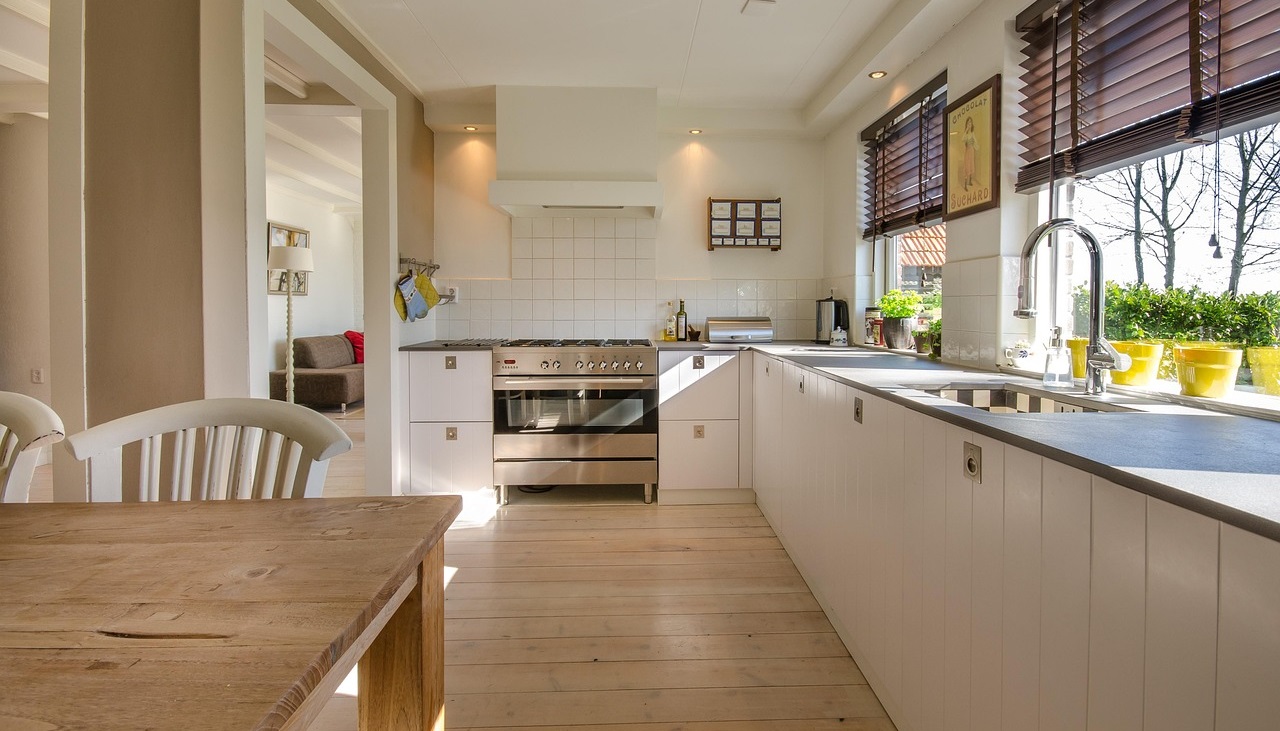Now Reading: Best Kitchen Layouts for Every Home: L-Shaped, U-Shaped, and More
-
01
Best Kitchen Layouts for Every Home: L-Shaped, U-Shaped, and More
Best Kitchen Layouts for Every Home: L-Shaped, U-Shaped, and More

Choosing the right kitchen layout is a critical step in any remodel, as it directly impacts functionality, aesthetics, and workflow. Whether you’re working with a spacious open-plan area or a compact apartment kitchen, the layout you select can make or break your daily cooking experience.
This guide explores the most popular kitchen layouts—L-shaped, U-shaped, galley, island, and peninsula, detailing their pros, cons, and ideal use cases to help you find the perfect fit for your home in 2025.
Why Kitchen Layout Matters
A well-designed kitchen layout optimizes the “work triangle” (the path between the sink, stove, and refrigerator), enhances storage, and complements your lifestyle. Before diving into specific layouts, consider your needs: Do you cook frequently?
Entertain guests? Need space for a family? Each layout offers unique benefits, so let’s break down the options.
1. L-Shaped Kitchen Layout
Overview
The L-shaped kitchen features cabinets and appliances along two adjacent walls, forming an “L.” It’s one of the most versatile layouts, suitable for small to medium-sized spaces and open-plan homes.
Pros
- Flexible Design: Works in both small and large spaces, leaving room for a dining table or island.
- Efficient Work Triangle: Keeps sink, stove, and refrigerator close for streamlined cooking.
- Open Feel: Ideal for open-plan homes, allowing interaction with living or dining areas.
- Corner Storage: Maximizes corner space with pull-out cabinets or lazy Susans.
Cons
- Limited Counter Space in Small Kitchens: May feel cramped without strategic planning.
- Corner Challenges: Accessing deep corner cabinets can be tricky without specialized storage solutions.
- Less Ideal for Multiple Cooks: Can feel congested if multiple people are cooking.
Best For
- Small to medium kitchens.
- Homes with open-plan living areas.
- Homeowners who want a balance of functionality and openness.
Design Tip
Incorporate a small island or breakfast bar in larger L-shaped kitchens to add counter space and casual dining. Use corner carousels or pull-out shelves to maximize storage.
2. U-Shaped Kitchen Layout
Overview
The U-shaped kitchen, also called a horseshoe layout, features cabinets and appliances along three walls, forming a “U.” It’s ideal for those who need ample storage and counter space.
Pros
- Abundant Storage: Three walls provide plenty of cabinet and countertop space.
- Efficient Workflow: Keeps the work triangle compact, ideal for serious cooks.
- Versatile: Works in small to large kitchens, with the option to add an island in bigger spaces.
- Private Feel: Enclosed design feels cozy and focused.
Cons
- Can Feel Closed Off: Less ideal for open-plan homes unless one wall is removed.
- Corner Access Issues: Similar to L-shaped, corners can be hard to reach without proper storage solutions.
- Space-Intensive: May overwhelm very small kitchens.
Best For
- Medium to large kitchens.
- Home cooks who prioritize storage and prep space.
- Families needing multiple workstations.
Design Tip
Add open shelving or glass-front cabinets on one wall to reduce the closed-in feel. In larger U-shaped kitchens, consider a peninsula or island for extra functionality.
3. Galley Kitchen Layout
Overview
The galley kitchen, or corridor kitchen, features two parallel walls with a walkway in between. It’s a classic choice for narrow or small spaces, maximizing efficiency in a compact footprint.
Pros
- Highly Efficient: Compact layout minimizes movement between appliances.
- Cost-Effective: Requires fewer cabinets and less countertop material.
- Streamlined Look: Sleek, minimalist design suits modern aesthetics.
- Great for Small Spaces: Fits apartments or older homes with narrow kitchens.
Cons
- Limited Space: Can feel cramped, especially with multiple cooks.
- Minimal Counter Space: Less room for prep or appliances.
- Closed-Off Vibe: Not ideal for entertaining or socializing.
Best For
- Small apartments or homes.
- Single cooks or minimalists.
- Budget-conscious remodels.
Design Tip
Use light colors and reflective surfaces (e.g., glossy backsplashes) to make a galley kitchen feel larger. Add pull-out drawers or vertical storage to maximize space.
4. Island Kitchen Layout
Overview
The island kitchen is typically an L-shaped or U-shaped layout with a freestanding island in the center. The island serves as additional counter space, storage, or a casual dining area.
Pros
- Versatile Functionality: Island can be used for prep, dining, or socializing.
- Social Hub: Perfect for entertaining guests or family gatherings.
- Extra Storage: Islands often include cabinets or shelves underneath.
- Customizable: Can incorporate a sink, stove, or bar seating.
Cons
- Space-Hungry: Requires a large kitchen to avoid feeling cramped.
- Expensive: Adding an island increases remodeling costs.
- Disrupts Workflow: Poorly placed islands can hinder the work triangle.
Best For
- Large, open-plan kitchens.
- Families or frequent entertainers.
- Homeowners wanting a statement piece.
Design Tip
Choose a multifunctional island with built-in appliances or seating. Ensure at least 36–48 inches of clearance around the island for easy movement.
5. Peninsula Kitchen Layout
Overview
Similar to an island layout, the peninsula kitchen features a counter that extends from a wall or cabinetry, forming a partial barrier. It’s a great compromise for smaller spaces.
Pros
- Space-Saving: Requires less room than a full island.
- Extra Counter Space: Adds prep or dining space without dominating the kitchen.
- Open Yet Defined: Creates a partial separation between kitchen and living areas.
- Affordable: Less costly than a full island.
Cons
- Limited Accessibility: Only accessible from three sides, unlike an island.
- Can Feel Restrictive: May block flow in very small kitchens.
- Less Storage: Offers less cabinet space than an island.
Best For
- Small to medium kitchens.
- Homes needing a partial open-plan feel.
- Budget-conscious remodels.
Design Tip
Use the peninsula as a breakfast bar or casual workspace. Incorporate pendant lighting above to enhance ambiance and define the space.
Choosing the Right Layout for Your Home
To select the best kitchen layout, consider these factors:
- Space: Measure your kitchen’s dimensions. Small spaces suit galley or L-shaped layouts, while larger areas can accommodate islands or U-shapes.
- Lifestyle: Frequent cooks may prefer U-shaped or galley kitchens for efficiency, while entertainers might choose island or peninsula layouts for socializing.
- Budget: Galley and L-shaped layouts are typically more affordable, while islands add significant costs.
- Aesthetics: Match the layout to your home’s style (e.g., galley for modern, island for transitional).
For more guidance and ideas, you can consult I.S. Hager Building & Remodeling for your kitchen remodeling work.
Visualizing Your Kitchen Layout
To help plan your remodel, use free online tools like RoomSketcher or Planner 5D to create 3D renderings of your layout. Alternatively, sketch your kitchen’s dimensions and mark the work triangle to ensure efficient flow. For inspiration, check out these simplified diagrams:
- L-Shaped: Two walls forming an L, with an optional island or table in the open space.
- U-Shaped: Three walls enclosing the kitchen, with appliances spread across each.
- Galley: Two parallel walls, with sink and stove on opposite sides.
- Island: An L- or U-shaped base with a central freestanding counter.
- Peninsula: An L-shaped base with a counter extending from one wall.
Final Thoughts
The best kitchen layout depends on your space, lifestyle, and budget. L-shaped and galley kitchens are ideal for smaller homes or budget-conscious remodels, while U-shaped, island, and peninsula layouts suit larger spaces or those prioritizing storage and socializing. Before starting your remodel, consult a designer or contractor to ensure your chosen layout maximizes functionality and complies with local building codes.
Ready to start your kitchen remodel? Share your space’s dimensions and needs with a professional to bring your vision to life. For more inspiration, explore our guides on kitchen remodeling trends or cost breakdowns for 2025.
Image by Rudy and Peter Skitterians from Pixabay










